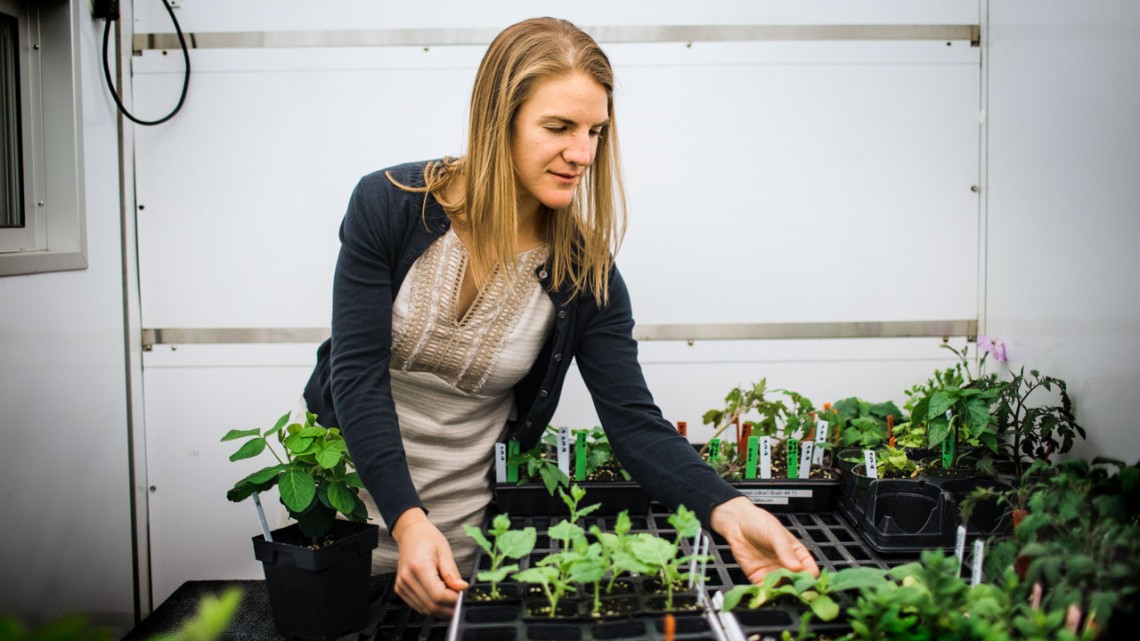Scientists know that some mRNA – which carries genetic code to a living organism’s protein-making machinery – are making the journey from root to shoot. But they don’t know which of the thousands of strands are purposely trying to share genetic information between organ systems.
This is a critical question, especially when it comes to plant grafting. That’s where mobile mRNA could be used to carry signals across organ systems and help alter plants’ responses to environmental stresses.
Margaret Frank, assistant professor of plant biology at Cornell University, is tackling this problem by developing a model to observe the real-time movement of mRNA through plant systems.
The National Science Foundation recently awarded Frank a five-year, $1.3 million Faculty Early Career Development Program grant for her proposal, “Harnessing the Plant Mobileome to Predict, Design, and Deliver Long-Distance RNAs in Plants.”
Frank will use computational analysis to separate the signals from the noise and determine the role of specific mRNAs in long-distancing signaling, with the hope of eventually engineering a method for using mRNA to deliver targeted information across grafted plant systems.
“There’s a lot of potential that comes from a better understanding of how mRNAs are delivered through the plant and their potential to translate into signals,” Frank said. “One of the pie-in-the-sky goals is to be able to graft on a donor branch that rapidly alters [a crop’s] flowering time in response to temperature, for example, which would be really impactful in light of climate change.”
However, most of what scientists already know about mRNAs is limited to their role in translating DNA into expressed proteins within individual cells where they are produced.
Frank’s project will observe the mobile mRNA over long distances to understand what, if any, genetic information is getting transferred between different organs of different species – in this case, eggplant and tomato.
“Those genomes are sufficiently diverged,” Frank said, “that we can track almost all the RNAs that are generated from eggplant versus tomato, and see at the genomic scale which RNAs are moving from the root to the shoot, or the shoot to the root.”
Frank’s lab has already demonstrated that the two species are graft-compatible. Now they’re generating a reference genome for an eggplant variety from the Bangladesh Agricultural Research Institute, which will not only be used in this study, but will also benefit plant breeders around the world. (A reference genome for tomatoes already exists.)
The second part of the project involves creating a live imaging system to monitor the mRNAs’ movement through the vasculature of the grafted plants. Frank’s team will track the thousands of mRNAs over daily cycles and through developmental time periods, from early in the plant’s life cycle through reproductive development.
To keep tabs on so many moving parts, Frank’s team will tag the mRNAs using fluorescence imaging to monitor their real-time movement. Then, to make sure that the tracking is accurate, the researchers will harvest tissue samples and use a technique called RNA PAINT to pinpoint how the different eggplant and tomato mRNA strands moved through the grafted plants.
“RNA PAINT allows you to actually paint RNA transcripts in nonliving tissue,” Frank said. “So you can harvest the tissue and then look at where RNAs are at the subcellular level.”
Using this combination of live tracking, tissue sampling and bioinformatics, the team should be able to determine on the genomic scale whether the mRNA movement is related to passive fluctuation or if it takes a more targeted approach. If the latter is true, then Frank will have solved the mystery regarding mRNA’s role as long-distance signal carriers in plant systems.
The final phase of the project will build a targeted delivery system for mRNA to cross the graft junction and deposit genetic information into the other species’ organ systems. By identifying the traits that make the existing mRNAs mobile, the researchers hope to activate long-distance signaling mechanisms in other mRNAs and program them to deliver specific DNA transcripts.
Other partners include researchers at the University of California, Berkeley; Michigan State University; the University of Delaware; the Bangladesh Agricultural Research Institute; HudsonAlpha Institute for Biotechnology; and the University of Southampton, in the U.K. CALS Research Development.
For additional information, see this Cornell Chronicle story.
-30-
Original post https://alertarticles.info


